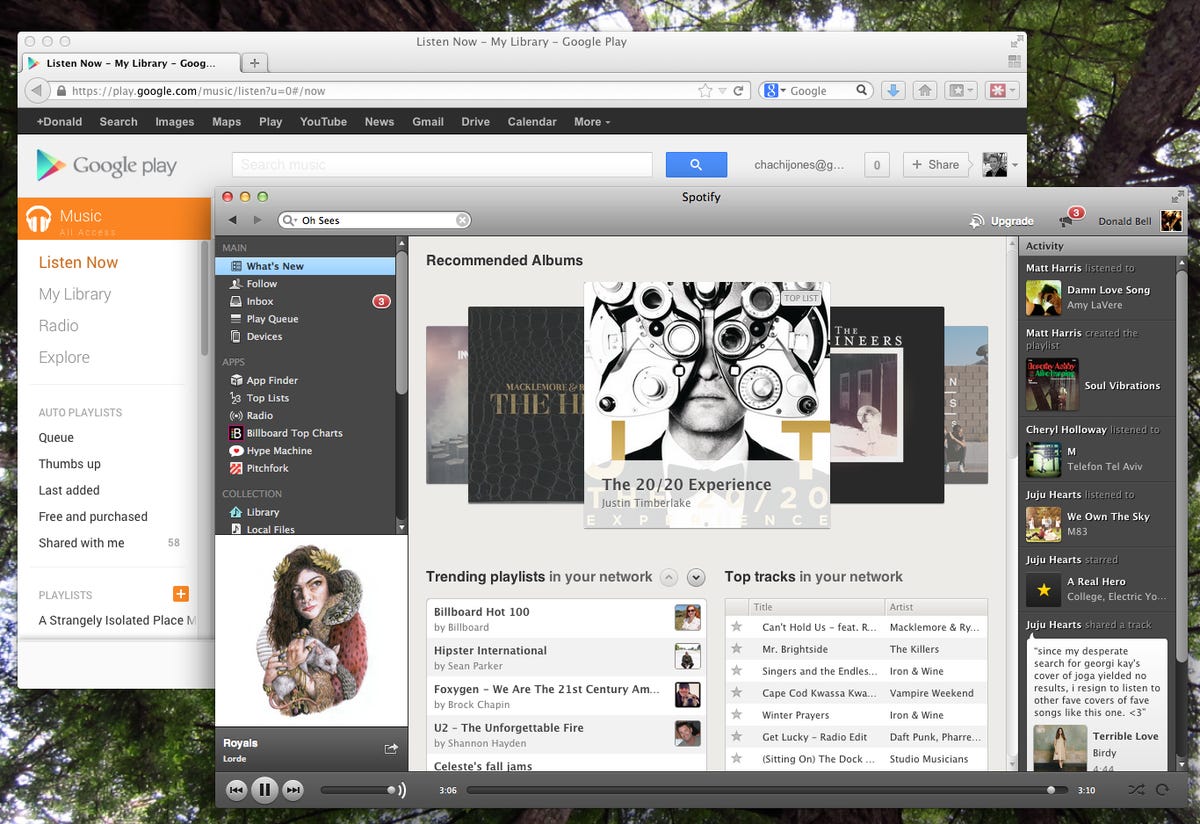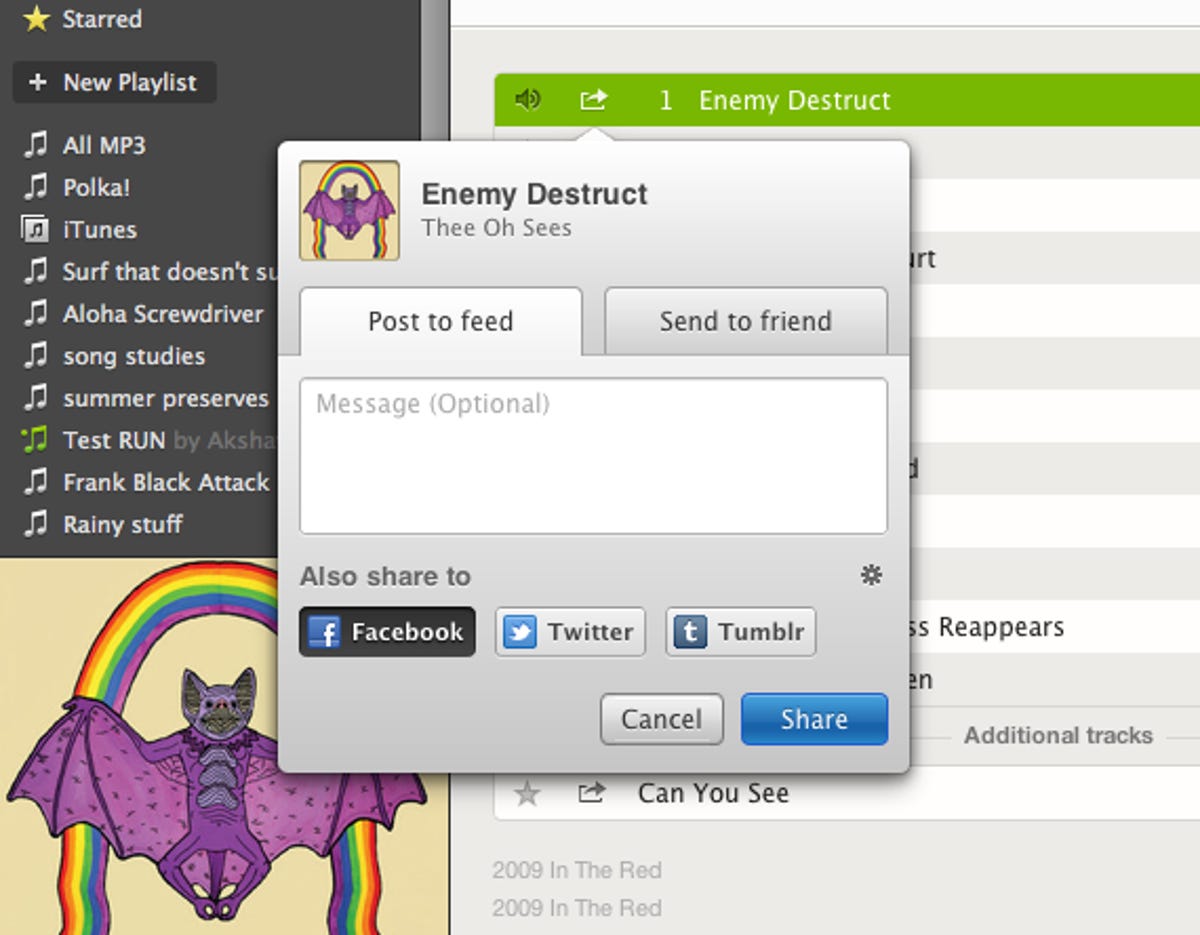
Screenshot by Donald Bell/CNET
New music services are great at making me feel old.
Opening Spotify is like opening the door to some hip cafe where a mustached 20-year old barista takes my order with folded arms and a stamp on his hand from last night’s secret show. I feel not just a little lame. But instead of running for the door like the curmudgeon that I am, yearning for the comfortable embrace of my iTunes collection, I stay.
I stay because even in these days of free apps, free video streams, and free e-books, I’m still totally enthralled by the idea of running loose in an infinitely large music store and listening to anything I want. To anyone who grew up marching down to their local record store for the privilege of paying $18 for a single CD, all-you-can-eat music services such as Spotify, Rdio, and Mog still feel like a gluttonous, forbidden orgy of sound. Even the minor miracle of Pandora still puts a smile on my face.
All Access music service for Google Play (pictures)






+3 more
So it should come as no surprise that the Google is getting in on the action. Its Google Play Music All Access, announced at Google I/O 2013, takes its existing music service and tacks on the option of unlimited streaming access to its entire music catalog for the cost of $9.99 per month. To sweeten the deal, Google tossed in a limited-time discounted price of $7.99 per month for customers who sign up before June 30.
But is this the perfect end-all subscription service for music fans? Is this Gmail for music? To find out, I spent the better part of my day bouncing back and forth between Google’s All Access service and the popular front-runner, Spotify.
Yes, I get paid for this. Thank you, English degree.
table.geekbox th{background-color:#E6ECEF;text-align:center;font-weight:bold;}
table{width:600px;} table.geekbox tr.even{background-color:#CCCCCC;}
.ratingGood{color:#093;} .ratingAverage{color:#666;} .ratingBad{color:#C00;}
| All-Access | Spotify | |
|---|---|---|
| Premium plans | $9.99/mo | $4.99/mo (desktop) $9.99/mo (mobile) |
| Free option | No | Yes |
| iOS app | No | Yes |
| Android app | Yes | Yes |
| Windows Phone 8 app | No | Yes |
| Desktop app | No | Yes |
| Offline playback | Yes | Yes |
| Twitter share | No | Yes |
| Facebook share | No | Yes |
| Google+ share | Yes | No |
| Tumblr share | No | Yes |
| E-mail playlists | Limited | Yes |
| Radio | Yes | Yes |
| Playlists | Yes | Yes |
| Cloud storage | Yes | No |
| Scrobble | No | Yes |
| Gapless | No | Yes |
| Queue sync | No | No |
| Quality modes | 2 | 3 |
| Third-party apps | No | Yes |
| Global reach | U.S.-only | 30+ countries |


Now playing:
Watch this:
Google Music’s Pandora-killer
2:47
Reading the results
First of all, let me just say that the subject of music catalog size wasn’t easy to distill into a chart. The numbers are fuzzy on both sides, but in general I found a more exhaustive selection available on Spotify. With both services including all three major labels and claiming to have cast a wide net for all the indies they can gather, I couldn’t find many artists that weren’t shared by both companies. That said, within the artist’s catalog, I found that Spotify often had more more rarities and collections not included on Google.
Related stories
- Best TV Streaming Service Deals
- Watch Trailer for ‘The Playlist,’ a Netflix Drama About the Rise of Spotify
- Best Wi-Fi Speaker for 2022
I’ll also say that in terms of sound quality, both services offered the capability of forcing the stream into a high-quality-only mode. Google doesn’t mention a specific bit rate. If you’re picky and holding your breath for a pristine, lossless streaming music service, then neither of these options is what you’re looking for.
Now, if we’re to give an evenly weighted score for each of the criteria outlined in the chart above, Spotify is the clear winner. In fact, even if you award a disproportionate number of points for the few places where Google comes out ahead (cloud locker, Google+ integration), it’s still a massacre.
For the moment, Spotify simply offers broader OS and hardware support, more flexibility on the kind of plan you pay for (including a free, ad-supported option), and delivers more ways to share the music you love with the people connected to you through Twitter, Facebook, Tumblr, Last.fm, and even just a straight-up e-mail.


Donald Bell
And then there’s its app platform, where outlets such as Billboard, Pitchfork, Rolling Stone, Blue Note, and others can offer their own brand of music discovery and curation. It’s an impressive playground of brands and startups that add an extra, fun dimension to the whole experience and a useful secondary perspective to what can otherwise be a daunting monolith of music.
And here’s the funny part. Before Google launched All-Access, I rarely came to the defense of Spotify. For reasons that I won’t even start to get in to, I had pretty much written off Spotify’s entire business model as the death knell of the music industry (both good and bad). But when a company with as many resources as Google squirts out something as watered down as All Access, I feel righteously compelled to point out the many clear advantages of choosing Spotify instead.
Tune in next month when I repeat this same argument against what will likely be Apple’s even more poorly conceived and restrictive plan for an iTunes subscription program. Until then, go out and see some live music, and maybe even grow out your mustache.



